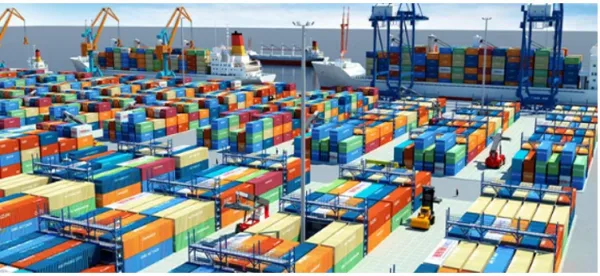The Diversity of the Logistics Industry
Logistics is a crucial field in business and economics, involving the management and transportation of goods, information, and resources from the point of origin to the destination. Logistics emerged and was officially applied in business in the 1970s. The Supply Chain Logistics phase developed in the 1980s, where logistics activities became interconnected in a unified chain among companies. There is a serious shortage of human resources. It is estimated that in the upcoming years, companies will need between 200,000 and 700,000 individuals. Therefore, Hoa Binh University has opened up 2339 enrollment slots to meet this demand.
When studying Logistics at Hoa Binh University, students will delve deeply into logistics and will be provided with opportunities for practical experiences at various businesses to get as close as possible to Logistics and logistics enterprises. Logistics can be described as a support activity, planning and executing processes to ensure the smooth flow of goods from raw materials to finished products and ultimately to the end consumers, satisfying their needs.

At Hoa Binh University, we have a dedicated, experienced, and highly professional team of lecturers. We always strive tirelessly to provide the best quality education for students. When studying Logistics, you will have the opportunity to meet with Associate Professor Nghiem Van Trong.

Dr. Nghiem Van Trong has 10 years of experience leading numerous students in internships at other institutions such as the Agricultural Academy, the University of Natural Resources and Environment, and the University of Natural Sciences. He spent two years teaching courses in Food Science, Economic and Technical Standards, and Negotiation in Business Logistics.
Some key aspects of the Logistics industry
Supply chain management: This is the process of managing the entire flow of goods, information, and finances from the raw material supplier to the end customer. It involves planning, implementing, and monitoring all activities within the supply chain.

Transportation: This includes all means of transporting goods such as road, rail, sea, air, and pipelines. Selecting the appropriate mode of transportation is a crucial factor in ensuring efficiency and cost savings.

Warehousing: Warehouse management involves the storage and preservation of goods in transit warehouses or distribution centers. This includes activities such as inventory management, storage, and internal transportation within the warehouse.

Inventory Management: It is the process of monitoring and controlling the amount of inventory to ensure that there is enough stock to meet customer demand without incurring excessive storage costs.

Information Systems: Utilizing technologies and information systems to manage and track logistics activities, including order management, shipment tracking, and warehouse management.

Customer Service: Ensuring that customers receive goods on time and in the best condition. This includes addressing issues related to deliveries and providing customer support.

Supplier Management: Working with suppliers to ensure that raw materials and goods are provided on time and meet quality standards.

The Logistics industry requires knowledge and skills in various fields, including management, economics, engineering, and information technology. It is a rapidly growing sector and increasingly vital in the context of globalized economy.
The Role and Importance of Logistics
Logistics plays a crucial role in enhancing business operations’ efficiency and creating value for customers. An effective logistics system helps reduce transportation costs, optimize warehouse management, and enhance the quality of customer service. This contributes to improving a company’s competitiveness in the market.
Challenges
- High Transportation Costs: Increasing fuel prices and transportation costs can reduce a company’s profits.
- Risk Management: This includes risks related to natural disasters, technical failures, and legal issues.
- Labor Shortages: The logistics industry is facing a shortage of skilled labor.
Opportunities
- New Technologies: The development of technologies such as artificial intelligence, blockchain, and the Internet of Things (IoT) is opening many new opportunities for the logistics industry.
- Global Market: The growth of e-commerce and the global market create a high demand for logistics services.
- Sustainable Development: The trend towards sustainable and green logistics is becoming an important factor in attracting customers.
Trends in Development in the Logistics Industry
- Automation and Digitization: Using robots and automation systems in warehouses and transportation to enhance efficiency and reduce costs.
- Green Logistics: Utilizing environmentally friendly transportation and optimizing processes to reduce carbon emissions.
- Global Network Development: Expanding and developing global logistics networks to meet the increasing demands of international trade.
Some of Reference Materials:
- Ha Minh Hieu. Logistics Management and Supply Chain. Financial Publishing House.
- Dr. Nguyen Thanh Hieu. Textbook on Supply Chain Management. National Economics University Publishing House. Published in 2015.
Prof. Dr. Dang Dinh Dao, Assoc. Prof. Dr. Tran Van Bao, Dr. Pham Canh Huy, Dr. Dang Thi Thuy Hong (co-editors). Textbook on Logistics Management. Hanoi University of Science and Technology Publishing House.





